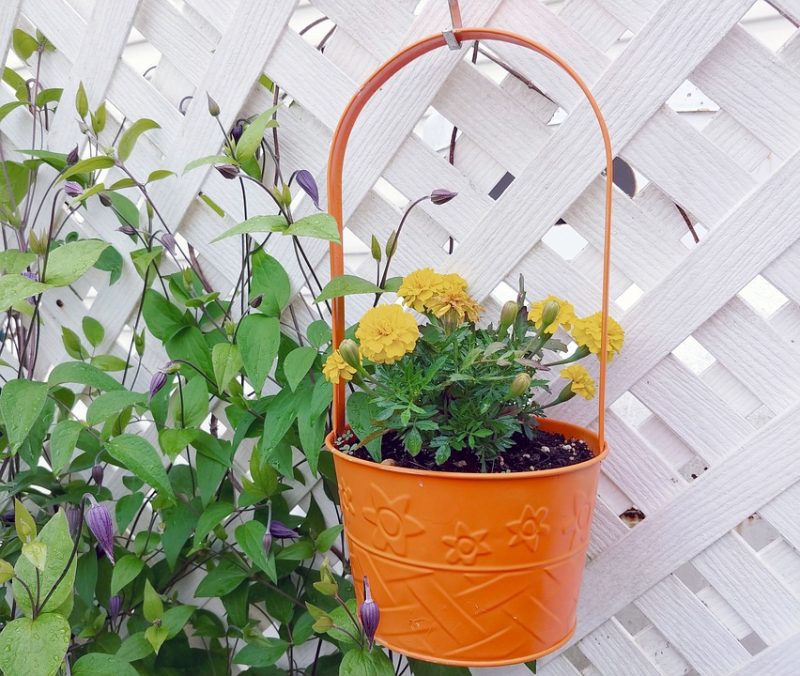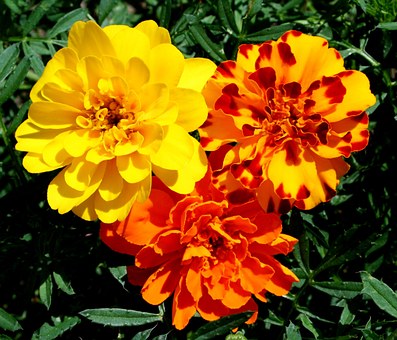Marigolds, planting guide and care work
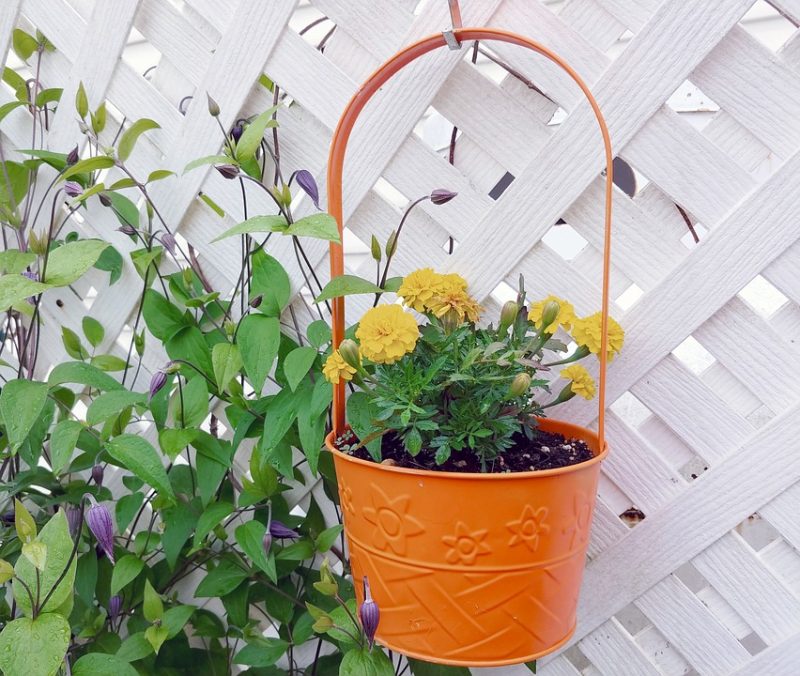
Marigold (Tagetes sp.) are annual herbaceous plants native to America. They belong to the order Asterales, to the Asteraceae botanical family. Due to the beautifully colored flowers and the low demands in terms of environmental conditions, the marigolds have been introduced over time in most countries with temperate climates, and not only. They are cultivated to decorate parks, gardens, terraces, roundabouts and street alignments throughout the summer.
Species, varieties and cultivars
Over time, dozens of species of marigolds have been identified, and still on so many varieties, cultivars and hybrids.
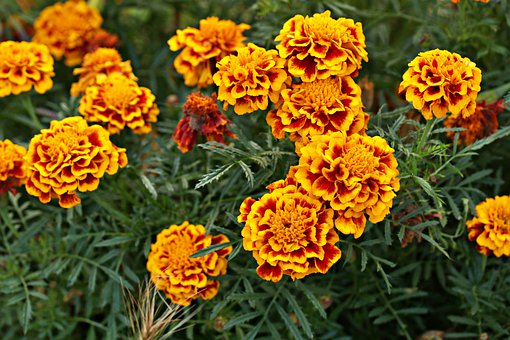
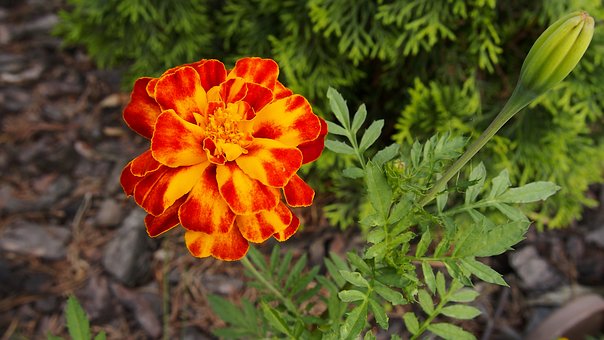
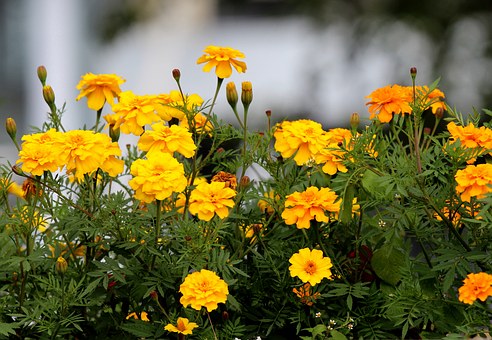
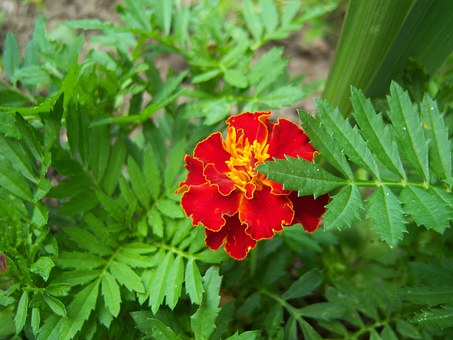
Tagetes patula
It reaches heights of approx. half a meter, has a straight stem, erect and it is strongly branched. The leaves are small and narrow, pinnately compound, with deep and narrow indentations, oppositely arranged along the stem. Crushed, it gives off a specific smell. The flowers are solitary, long peduncled, large (usually 3-6 cm in diameter, in the case of some cultivars up to 6-12 cm) and have many petals with fringed edges. They can be single-colored or bicolor, mostly yellow and orange.
There are dozens of varieties and cultivars, among which we mention:
- Tagetes patula var. nana – Dwarf marigold
- Tagetes patula ‘Golden Boy’
- Tagetes patula ‘Aurora Orange’
- Tagetes patula ‘Alumia Vanilla Cream’
- Tagetes patula ‘Tiger Eyes’
Tagetes erecta
It is native to Central America. It has higher vigor than the previous species (heights of 100-120 cm), but it is very similar to it. While Tagetus patula is more branched at the base of the stem, Tagetus erecta has more branches at the topside.
Tagetes tenuifolia
It has very small leaves, approx. 3 cm long, and flowers with 5 large, wide, yellow petals. There are various cultivars of Tagetes tenuifolia, in which the color of the flowers can vary from brown to orange and yellow. It is cultivated in some regions for its edible flowers, with a sour aroma, used especially to decorate plates.
Tagetes lucida
It has shiny, entire leaves (up to 7-8 cm long). The flowers are yellow or orange, terminally positioned, clustered in groups of 2-3 in capitula. In some regions it is cultivated for therapeutic purposes, the dried flowers being used in teas.
Tagetes minuta
It reaches great heights, up to 2 m. It is cultivated in some regions (South Africa, in particular) to be used in cosmetics, essential oils and perfumes. It is also used dry or grinded, as a spice.
Recommended products
-
You can find products on a different store
Change Store -
You can find products on a different store
Change Store -
You can find products on a different store
Change Store -
You can find products on a different store
Change Store -
You can find products on a different store
Change Store -
You can find products on a different store
Change Store -
You can find products on a different store
Change Store -
You can find products on a different store
Change Store -
You can find products on a different store
Change Store -
You can find products on a different store
Change Store -
You can find products on a different store
Change Store -
You can find products on a different store
Change Store -
You can find products on a different store
Change Store -
You can find products on a different store
Change Store -
You can find products on a different store
Change Store -
You can find products on a different store
Change Store -
You can find products on a different store
Change Store -
You can find products on a different store
Change Store -
You can find products on a different store
Change Store -
You can find products on a different store
Change Store -
You can find products on a different store
Change Store -
You can find products on a different store
Change Store -
You can find products on a different store
Change Store -
You can find products on a different store
Change Store
Environmental conditions
Light. Marigolds develop properly and bloom abundantly in strong light conditions.
Temperature. They are heat-loving species, the seeds germinate at temperatures above approx. 18. In autumn, mature marigolds are resistant to low temperatures, often blooming until the first frost.
Soil. Substrate. They are tolerant species in terms of edaphic conditions, vegetating satisfactorily on most soil types. However, they grow vigorously on fertile, well-drained and aerated soils.
Care
Water. Regular watering is recommended, with moderate amounts of water. Marigolds can withstand better the lack of water (drought) for short periods of time, than excessive moisture at ground level.
Fertilization. For abundant flowering, vigorous growth and resistance to diseases and pests, it is recommended to regularly apply specific fertilizers.
Recommended products
-
You can find products on a different store
Change Store -
You can find products on a different store
Change Store -
You can find products on a different store
Change Store -
You can find products on a different store
Change Store -
You can find products on a different store
Change Store -
You can find products on a different store
Change Store -
You can find products on a different store
Change Store -
You can find products on a different store
Change Store -
You can find products on a different store
Change Store -
You can find products on a different store
Change Store -
You can find products on a different store
Change Store -
You can find products on a different store
Change Store -
You can find products on a different store
Change Store -
You can find products on a different store
Change Store -
You can find products on a different store
Change Store -
You can find products on a different store
Change Store -
You can find products on a different store
Change Store -
You can find products on a different store
Change Store -
You can find products on a different store
Change Store -
You can find products on a different store
Change Store -
You can find products on a different store
Change Store -
You can find products on a different store
Change Store -
You can find products on a different store
Change Store -
You can find products on a different store
Change Store
Care works. Marigolds are species that do not require special care works. After sprouting, if necessary, it is possible to remove weeds that can overwhelm the plants. Additionally, withered and dry flowers or damaged leaves can be removed whenever needed.
Sowing. In the case of protected areas (greenhouses), sowing is done in March or April. In the case of direct sowing (outdoors), the optimal period is April-May. In the garden, if the flowers are left on the stem until the seeds mature, they fall to the ground and ensure natural seeding for the next year.
Recommended products
-
You can find products on a different store
Change Store -
You can find products on a different store
Change Store -
You can find products on a different store
Change Store -
You can find products on a different store
Change Store -
You can find products on a different store
Change Store -
You can find products on a different store
Change Store -
You can find products on a different store
Change Store -
You can find products on a different store
Change Store -
You can find products on a different store
Change Store -
You can find products on a different store
Change Store -
You can find products on a different store
Change Store -
You can find products on a different store
Change Store -
You can find products on a different store
Change Store -
You can find products on a different store
Change Store -
You can find products on a different store
Change Store -
You can find products on a different store
Change Store -
You can find products on a different store
Change Store -
You can find products on a different store
Change Store -
You can find products on a different store
Change Store -
You can find products on a different store
Change Store -
You can find products on a different store
Change Store -
You can find products on a different store
Change Store -
You can find products on a different store
Change Store -
You can find products on a different store
Change Store
Planting. It is done in spring, when there is no risk of frost or hoarfrost (May). The optimal distance between plants is approx. 15×20 cm. If deemed necessary, young plants with 2-3 true leaves can be transplanted into flower pots or nests, at distances of 4-5 cm between specimens.
Propagation. Marigolds are propagated by germination, through seeds.
Diseases and pests. Marigolds are usually resistant to diseases and pests. However, they can be affected by diseases such as gray mold, Alternaria, powdery mildew, leaf spot or various viruses. Specific preventive and control treatments with fungicides need to be applied.
Recommended products
-
You can find products on a different store
Change Store -
You can find products on a different store
Change Store -
You can find products on a different store
Change Store -
You can find products on a different store
Change Store -
You can find products on a different store
Change Store -
You can find products on a different store
Change Store -
You can find products on a different store
Change Store -
You can find products on a different store
Change Store -
You can find products on a different store
Change Store -
You can find products on a different store
Change Store -
You can find products on a different store
Change Store -
You can find products on a different store
Change Store -
You can find products on a different store
Change Store -
You can find products on a different store
Change Store -
You can find products on a different store
Change Store -
You can find products on a different store
Change Store -
You can find products on a different store
Change Store -
You can find products on a different store
Change Store -
You can find products on a different store
Change Store -
You can find products on a different store
Change Store -
You can find products on a different store
Change Store -
You can find products on a different store
Change Store -
You can find products on a different store
Change Store -
You can find products on a different store
Change Store
Pests such as aphids, mites, thrips or the caterpillars of some types of butterfly species can attack the leaves and flowers of marigolds. Specific insecticides will be used against them. Slugs and snails can consume the vegetal organs of marigolds. Various traps can be used.
Recommended products
-
You can find products on a different store
Change Store -
You can find products on a different store
Change Store -
You can find products on a different store
Change Store -
You can find products on a different store
Change Store -
You can find products on a different store
Change Store -
You can find products on a different store
Change Store -
You can find products on a different store
Change Store -
You can find products on a different store
Change Store -
You can find products on a different store
Change Store -
You can find products on a different store
Change Store -
You can find products on a different store
Change Store -
You can find products on a different store
Change Store -
You can find products on a different store
Change Store -
You can find products on a different store
Change Store -
You can find products on a different store
Change Store -
You can find products on a different store
Change Store -
You can find products on a different store
Change Store -
You can find products on a different store
Change Store -
You can find products on a different store
Change Store -
You can find products on a different store
Change Store -
You can find products on a different store
Change Store -
You can find products on a different store
Change Store -
You can find products on a different store
Change Store -
You can find products on a different store
Change Store
Additionally
- marigolds are also cultivated for bouquets and floral arrangements;
- some species of marigolds are used in the cosmetic, pharmaceutical and health care industry, respectively in the paint industry (for pigments obtained from the petals);
- various organs of some species of marigolds can cause skin irritation or can be toxic;
- pollination is entomophilic (with the help of insects, especially bees).














































































































































































































































































































































































































































